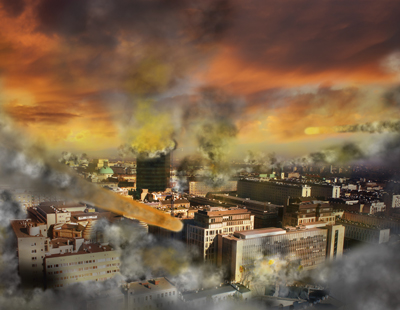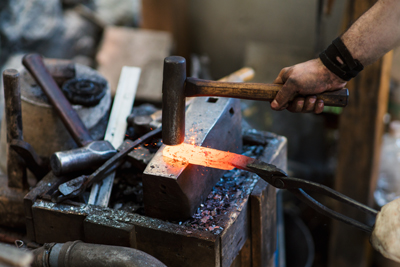
|
Science fiction has always included an element of human catastrophe. H. G. Wells probably started it with The War of the Worlds, about the devastation of an alien invasion, and The Time Machine, in which he looked beyond the horizon of current civilization to a brutal far-future world of Eloi and Morlocks. What-if—in terms of “What if things went terribly wrong?”—has always been part of the genre.1
Mainstream fiction picked up the catastrophic and world-changing mindset during and after World War II, if not before. Nevil Shute’s Ordeal, about a family coping with the aerial bombing of Southampton, which was actually written before the war, and his On the Beach, about an atomic cloud that envelopes the world after nuclear war and snuffs out the last of civilization in Australia, are the earliest works of apocalyptic fiction of which I was aware as a young reader. And then there was George Stewart’s Earth Abides, in which the human population is almost wiped out by a deadly disease—a thread that was later amplified by Stephen King in The Stand.
Certainly, the 20th century was ripe for visions of apocalypse. If World War I was a meatgrinder on the battlefield, then World War II was a horror on the home front as well, especially in view of saturation bombing of cities, mass deportations of enemy aliens and refugees, the Holocaust in Europe, and the two atomic bombs dropped on Japan. And all of this was followed by forty-four years of Cold War between the U.S. and the U.S.S.R. and the constant threat of a nuclear holocaust leading to the end of civilization. That threat was real enough, but there was also the historic, cultural threat of millennial devastation, fueled by some religious prophecies, leading to fears of Doomsday at the end of the first millennium and then the serial collapses projected for the year 2000: global population explosion, global cooling, global warming, and finally the recording of dates in the popular programming language COBOL, whereby allotting only two digits for the year would lead to the end of our computerized civilization.
As I’ve noted before, it’s fun to imagine the end of civilization. What would you do if you no longer had to get up and go to your job every day? Or no longer had to pay rent? Or do the grocery shopping and the laundry? Your hum-drum life would suddenly become exciting and unpredictable. Never mind that scrounging a living in a devastated world à la Cormac McCarthy’s The Road—where half of the picked-over leavings was irradiated and the other half simply poisoned—would be ten times harder than surviving as a current homeless person living off scraps from a dumpster that was refilled daily with the wastes of a thriving economy. Never mind that the population would quickly divide itself into those who still had some dignity and morals and were trying to cling to the vestiges of civilized life, and those who could brutalize and kill them without a thought just for the crust of stale bread in their pockets. Those details aside, it would be fun!
Today, almost twenty years after that fateful millennium year, we still entertain ourselves with visions of apocalypse and the derring-do that we would be forced to emulate in the midst of collapse. In regular waves, our novels and our movies—based in science fiction or not—saturate us with alien invasions, zombie uprisings, nuclear winter, and civilizational meltdown. About the only thing that has changed from the days of Nevil Shute and George Stewart is the emergence of a superhero literature and movie genre, escaping from the comic books—excuse me, “graphic novels”—of the years between the world wars. And still, every superhero sooner or later faces the threat of global catastrophe and civilizational collapse.
It’s fun to think of these scenarios because otherwise, and for the majority of us—at least for most of us with the leisure time to read and go to the movies—life is pretty tame. We have an abundance of goods and services at our disposal. We actually have income that we can call “disposable.” We have handheld devices that link us to every bit of information, every other person, every story and game that our active imaginations can crave and our curiosity could want to know and experience. In the classic line, we don’t have to wonder where our next meal is coming from but what we really feel like eating and where we want to go for lunch. Our lives are so damn good that we just cry out for something, anything, to change—especially drastically and for the worse.
But for some of us—maybe soon for most of us—this cultural background throb of doom and gloom is creating a pang of anxiety. Certainly, in the San Francisco Bay Area, we have been living with predictions of “the Big One”—a 7.9 or 8.0 on the Hayward or San Andreas faults—for more than fifty years. And that’s while the seismologists have given us positive odds of its occurrence “sometime in the next thirty years.” We all expect that will simply be the worst day of our lives, with everything changing, and being no fun at all.
In the country as a whole, we hear constant predictions of economic collapse, even though the markets are full, unemployment is at all-time lows, and stocks are at record highs. After the serial business downturns that have been part of our national economy since the Panic of 1837, we had the Crash of 1929 and the Great Depression in the 1930s. And then we reprised that disaster with a frisson of excitement in the Great Recession of 2007. And every year since, some renowned market analyst has predicted a stock market collapse of 50% or more and, among the wise, a flight to safety in terms of gold, real estate, bitcoins, or some other form of value.
In the widening divergence and hardening of differences between the two major parties comprising the left and the right, many people who are not at all crazy or conspiracy minded are seeing a “culture war” and a “cold civil war.” Some of us—myself included with one of the themes in my recent two-part novel Coming of Age—are even anticipating a heating up of that civil war into actual shooting status. Whether the conflict will be an orderly secession of certain states followed by the federal government’s attempt to recover them, as in the first American Civil War in 1861, or an attempted revolution followed by a subsequent revolt and civil war, as in Imperial Russia in 1917, or a running battle of town against town and neighbor against neighbor, as in the Spanish Civil War in 1936—all of that still remains to be seen. Many scenarios are possible. But if people of a political bent cannot learn to moderate their dreams, desires, and demands, if people on social media and in the punditry cannot agree that some viewpoint other than their own has merit and deserves respect, the threat of civil war still exists.
The apocalyptic vision is out there, floating like a mist in the public mind. Whether it brings you a sense of excitement or dread depends on your imagination and your point of view. But either way, it is a real thing and, sooner or later, we will have to deal with it.
1. I have covered this ground before, in Fantasies of the Apocalypse from August 9, 2015. Consider this “take two.”


